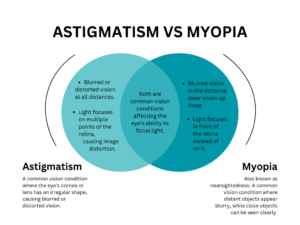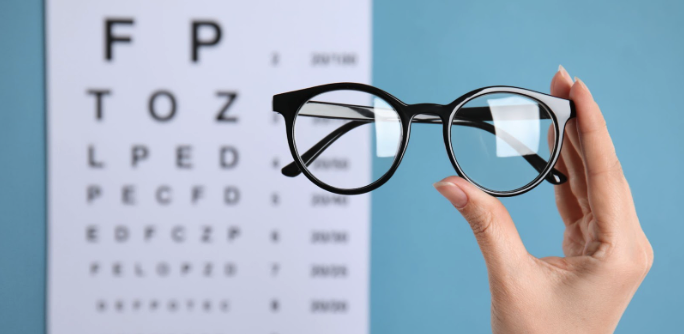Astigmatism vs Myopia
Astigmatism and myopia are two of the most common vision problems. There are similarities and differences between these two conditions, but they can also occur simultaneously. Known as refractive errors, both eye problems impact how your eyes focus light. It’s essential to know the difference between the two so that you fully understand your eye care needs.
While we can correct astigmatism and myopia with contact lenses and eyeglasses, they require different types of corrections. Astigmatism requires vision correction with cylindrical power. Laser correction surgery can typically assist with both vision problems, depending on the severity of your condition. When you understand the difference between astigmatism and myopia, you can take an active part in your eye health.
If you notice symptoms that include eye strain, headaches, and blurry distance vision, see one of our experienced eye doctors for an accurate diagnosis and treatment options. At Visionary Eye Doctors, your eye health and overall well-being are the main focus of our practice. Let us help you maintain clear vision for a lifetime.
Understanding Astigmatism
Astigmatism occurs when your cornea, which is the front surface of your eye, has an irregular shape. An irregularly shaped lens can also cause astigmatism. If you have astigmatism, your eye bends light in various directions instead of focusing light on a common point. You may experience eye strain, headaches, and poor night vision, as well as blurry vision at near and far distances. Many people are born with astigmatism which may be accompanied by farsightedness or nearsightedness (myopia).
Early diagnosis is key. That’s why it’s essential to schedule comprehensive eye exams. You should also contact our eye experts whenever you have a question about your vision. During your examination, you’ll receive a variety of tests to evaluate how your eyes bend light. Bright lighting and prescription contact lenses or eyeglasses can compensate for astigmatism, restoring clear vision. Laser correction surgery provides a more permanent solution, and most people can benefit from LASIK for astigmatism.
Understanding Myopia
Myopia is commonly referred to as nearsightedness. An elongated eyeball or curved cornea interferes with light rays entering the eye. This causes light to focus in front of the retina, so far objects appear unclear. However, you may clearly see near objects. Symptoms include squinting, eye strain, and headaches. This condition typically appears in childhood and may worsen as you grow older.
Treating myopia early can help prevent vision-threatening problems that may develop as you age. So, bring your children in for regular eye exams and schedule appointments to safeguard your eyesight. Your eye doctor will examine the structures of your eyes and test your vision to diagnose astigmatism, myopia, and other refractive errors.
 Differentiating Astigmatism and Myopia
Differentiating Astigmatism and Myopia
The visual characteristics of astigmatism and myopia differ based on how severe the condition is. However, they do share some common symptoms. While people with astigmatism have blurry vision at every distance, myopia typically does not impact near vision.
At the same time, both conditions cause eye strain and headaches. However, astigmatism may make night driving harder while myopia makes it difficult to see the whiteboard in school. Another key difference is that astigmatism requires eyeglasses or contact lenses with cylindrical power. Myopia requires vision aids that compensate for refractive errors.
Treatment Options for Astigmatism
Our team can typically treat astigmatism with eyeglasses, contact lenses, or refractive surgery.
Eyeglasses for Astigmatism
Eyeglasses with corrective lenses make up for an unevenly shaped eye. The lenses bend light so that it focuses on the retina. Some people prefer eyeglasses to contact lenses because they feel they are more comfortable and easier to use.
Contact Lenses to Treat Astigmatism
Like eyeglasses, contact lenses can correct most astigmatism. Toric contact lenses are designed to address astigmatism and are the most common type used to restore vision for this condition. The special shape of these lenses corrects for a misshaped lens or cornea.
You may opt for rigid contact lenses designed to correct the curvature of the eye. This process is called orthokeratology. Gradually, you’ll wear the lenses less often as your eye shape evens out. However, discontinuing the treatment may result in recurring refractive errors. Additionally, orthokeratology is more suited for mild to moderate cases of astigmatism.
Many people prefer contact lenses because they don’t want the inconvenience of wearing glasses. You may also prefer the look of contact lenses, which aren’t noticeable. However, it’s important to avoid wearing contact lenses for extended periods and use proper hygiene to store and clean them.
Ask your eye doctor about the pros and cons of contact lenses versus eyeglasses to treat your astigmatism.
Astigmatism Refractive Surgery
Our eye surgeon uses a laser beam to reshape your cornea and reverse the refractive error associated with astigmatism. You’ll undergo a thorough evaluation to determine whether you’re a good candidate for refractive surgery and which procedure would work best for you.
Here are the different kinds of surgery for astigmatism:
- Laser-assisted in-situ keratomileusis (LASIK). Using an excimer laser, our eye surgeon will make a hinged flap in the cornea and then sculpt the cornea to the appropriate shape.
- Photorefractive keratectomy (PRK). In this procedure, the protective cover is removed before the surgeon reshapes the cornea. The protective cover grows back naturally.
Treatment Options for Myopia
Eyeglasses and contact lenses are the primary methods of correcting myopia. However, there are also surgical options, including LASIK, PRK, and implantable lenses. Your eye doctor can help you determine the best method for your vision and lifestyle needs.
Eyeglasses for Myopia
Glasses are an effective solution to correct myopia. When you wear prescription eyeglasses, they change how light hits the retina to correct refractive errors. Eyeglasses are an ideal solution for children and adults with myopia and your eye doctor can provide a prescription following a routine eye exam.
Contact Lenses to Treat Myopia
Using the same vision tests, your doctor can provide a prescription for contact lenses that change the way light enters the eye. Contacts float on the surface of the cornea aided by your eye’s natural lubrication. Since they are set so close to the eye, they’re much thinner than glasses.
There are many types of contact lenses used to correct myopia:
- Soft lenses are made of flexible plastic material. They cover the iris, pupil, and some of the sclera (the white part of the eye). There are many options, including daily and weekly lenses you throw out when you’re done using them.
- Rigid lenses cover the pupil and the iris and are smaller than soft contacts. You’ll usually need to remove them at night, depending on the style you choose. Extended-wear rigid lenses are also available.
- Implantable Contact Lenses require surgery. Your eye surgeon will implant an aphakic IOL (intraocular lens) between the iris and your natural lens. Another kind of ICL is positioned between the cornea and the iris. These lenses can be removed if needed.
- Overnight contacts for myopia work the same way as orthokeratology contact lenses for astigmatism. They are worn only at night, and you’ll see clearly throughout the entire day. You have to wear ortho-k contacts every night to maintain your vision.
Myopia Corrective Eye Surgery
The only permanent treatment option for myopia is refractive surgery. Options include:
- Custom LASIK surgery (laser-assisted in-situ keratomileusis) corrects myopia and other refractive errors. It works the same way as LASIK for astigmatism.
- Photorefractive keratectomy (PRK) is less invasive and is performed directly on the surface of the eye. It’s a good option if you have a thin cornea or dry eyes.
- Refractive Lens Exchange (RLE) involves taking out your natural lens and replacing it with an intraocular lens implant (IOL). With RLE, you won’t have to worry about cataracts since the artificial lens will not deteriorate.
Coexistence of Astigmatism and Myopia
Having both irregular astigmatism and myopia is clearly not winning the vision lottery. However, these conditions can and do frequently coexist. If your cornea is too long and oddly shaped, symptoms may include blurrier vision than either of these conditions alone.
Here are some things to keep in mind if you have both astigmatism and myopia:
- Prescription contact lenses or eyeglasses must correct for both conditions.
- You may still notice some blurry vision, even when wearing your eyeglasses or contact lenses.
- You may need to wear your glasses or contact lenses at all times for both near and distant vision.
- Consider refractive surgery for a more permanent solution.
Lifestyle and Prevention Tips
You can sometimes prevent or slow the progression of astigmatism and myopia by following these tips:
- Limit time on digital devices, taking frequent breaks.
- Don’t read or work in dim light.
- Go outdoors and expose your eyes to natural light and distant objects.
- Wear sunglasses to block harmful UVA and UVB rays.
- Eat healthy foods that provide your eyes with essential nutrients.
- Schedule regular eye exams to prevent or detect any vision problems.
Visionary Eye Doctors provide LASIK and other refractive surgeries as well as prescriptions for eyeglasses and contact lenses. Contact us today for assistance overcoming myopia and astigmatism and restored vision.


